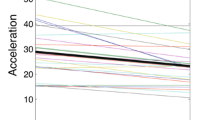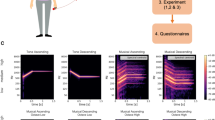Abstract
Dancing to a rhythm, as humans do, is a complex process, andformulation of its dynamics and control are very difficult. Rhythmicexchange of the support surfaces and stability of the overall systemare not well understood. To produce a dancing movement, simplermovements such as rocking, tapping, and stepping can be combined. Therhythm of dancing is usually driven by a music beat. A method thatextracts beats from a wide variety of music in real time ispresented. Work is being done to couple the extracted rhythm of themusic to a dancing biped. The seven degree of freedom sagittal bipedwith sixteen actuators is controlled to move in a rocking, tapping,and stepping fashion. A pattern generator is described which takes amusical beat and generates oscillations. The oscillations are usedto select a finite sequence of predefined desired states, and todrive the system from the current desired state to the next. Thesenext desired states allow derivation of neural excitation inputs tothe sixteen muscle-like actuators. Simulations show the feasibilityof the control strategy moving the biped from desired state todesired state as it traverses the trajectories of these three simplermovements of rocking, tapping, and stepping. In a final simulation,the three movements of rocking, stepping, and tapping are combined ina three-step up and down dancing movement.
Similar content being viewed by others
Explore related subjects
Discover the latest articles and news from researchers in related subjects, suggested using machine learning.References
Apel, W. 1972. Harvard Dictionary of Music, 2nd edition, Belknap Press of Harvard University Press: Cambridge, MA.
Bay, J.S. and Hemami, H. 1987. Modeling of a neural pattern generator with coupled nonlinear oscillators. IEEE Transactions on Biomedical Engineering, 34:297–306.
Berger, W., Dietz, V., and Quintern, J. 1984. Corrective reactions to stumbling in man: Neuronal coordination of bilateral leg muscle activity during gait. Journal of Physiology, 357:109–125.
Best, Roland E. 1984. Phase-Locked Loops, McGraw-Hill: New York.
Bregman, A.S. 1992. How does physiology support auditory scene analysis? In Auditory Physiology and Perception, Y. Cazals, L. Demany, and K. Horner (Eds.), Pergamon Press: Oxford, NY.
Brooks, V.B. 1986. The Neural Basis of Motor Control, Oxford University Press: New York.
Brown, J. and Frank, J. 1987. Influence of event anticipation on postural actions accompanying voluntary movement. Experimental Brain Research, 67:645–650.
Brown, J.C. 1993. Determination of meter of musical scores by autocorrelation. J. Acoust. Soc. Am., 94(4):1953–1957.
Ceranowicz, A.Z., Wyman, B.F., and Hemami, H. 1980. Control of constrained systems of controllability index two. IEEE Trans. on Automatic Control, 25(6):1102–1111.
Chen, B.-R., Hines, M.J., and Hemami, H. 1986. Dynamic modeling and implementation of a right turn in walking. Journal of Biomechanics, 19(3):195–206.
Collins, J.J. and Stewart, I.N. 1993. Coupled nonlinear oscillators and the symmetries of animal gaits. Journal of Nonlinear Science, 3:349–392.
Cooper, G. and Meyer, L.B. 1960. The Rhythmic Structure of Music, University Press of Chicago: Chicago, IL.
Crillner, S. 1995. Neural networks for vertebrate locomotion. Scientific American, 274(1):64–69.
DeLiang, Wang 1995. Temporal pattern processing. In The Handbook of Brain Theory and Neural Networks, M.A. Arbib (Ed.), M.I.T. Press: Cambridge, MA, pp. 967–971.
Dinneen, J.A. and Hemami, H. 1993. Stability and movement of a one-link neuro-musculo-skeletal sagittal arm. IEEE Transactions on Biomedical Engineering, 40(6):541–548.
Ellis, D.P.W. 1996. Prediction-driven computation auditory scene analysis. Ph.D. Dissertation, M.I.T., Cambridge, MA.
Flowers, K. 1978. The predictive control of behaviour: Appropriate and inappropriate actions beyond the input in a tracking task. Ergonomics, 21:109–122.
Fraisse, P. 1982. Rhythm tempo. In The Psychology of Music, D. Deutsch (Ed.), Academic Press: New York, NY.
Georgopoulos, A.P., Caminiti, R., Kalaska, J., and Massey, J. 1983. Spatial coding of movement: A hypothesis concerning the coding of movement direction by motor cortical populations. Experimental Brain Research, 7:327–336.
Georgopoulos, A.P. and Massey, J.T. 1988. Cognitive spatial motor processes. Experimental Brain Research, 69:315–326.
Geschwind, Norman 1979. Specializations of the human brain. Scientific American, 241(3):180–201.
Goto, M. and Muraoko, Y. 1996. Parallel implementation of a beat tracking system. Transactions on Information Processing Society of Japan, 37(7):1469–1468.
Groff, J.A. 1997. Coupling rhythmic movement to music: Algorithms for beat tracking. B.S. Thesis, The Ohio State University, Columbus, OH.
Handel, S. 1989. Listening, MIT Press: Cambridge, MA.
Hemami, H. 1980. A feedback on-off model of biped dynamics. Proceedings of the International Conference on Cybernetics and Society (1979), Vol. SMC-10, pp. 376–383.
Hemami, H., Tomovic, R., and Ceranowicz, A.Z. 1978. Finite state locomotion of planar bipeds with application to walking and sitting. Journal of Bioengineering, 2:477–494.
Hemami, H. and Wyman, B. 1979. Modeling and control of constrained dynamic systems with application to biped locomotion in the frontal plane. IEEE Transactions on Automatic Control, 24:526–535.
Hemami, H. and Wyman, B.F. 1980. Indirect control of the forces of constraint in dynamic systems. Journal of Dynamic Systems, Measurement and Control, 101:355–360.
Hemami, H. and Zheng, Y.-F. 1983. Dynamics and control of motion on the ground and in the air with application to biped robots. Journal of Robotic Systems, 1(1):101–116.
Hemami, H. and Dinneen, J. 1993. A marionette-based control strategy for stable movement. IEEE Transactions on Systems, Man and Cybernetics, 23(2):502–511.
Hemami, H. and Dinneen, J. 1995. Simple direction-dependent rhythmic movements and partial somesthesis of a marionette. IEEE Transactions on Systems, Man and Cybernetics, 25(11):1491–1500.
Hurmuzlu, Basdogan and Carollo, C. 1994. Presenting joint kinematics of human locomotion using phase plane portraits and poincare maps. Journal of Biomechanics, 27(11):217–234.
Jackendoff, R. 1992. Musical processing and musical affect. In Cognitive Bases of Musical Communication, M.R. Jonesand and S. Holleran (Eds.), American Psychological Association: Washington, WA.
Jagacinski, R. and Miller, R. 1987. Describing movement control at two levels of abstraction. In Human Factors Psychology, J. Hancock (Ed.), Elsevier Science Publishers: B.V. North Holland.
Jalics, Laci 1996. Trajectory planning for terrain adaptive locomotion and rhythmic movements of a neuromuscular biped, Ph.D. Dissertation, The Ohio State University, Columbus, OH 43210.
Jalics, L., Hemami, H., and Clymer, B. 1996. A control strategy for adaptive bipedal locomotion. Proceedings of the 1996 International Conference on Robotics and Automation.
Jalics, L., Hemami, H., and Clymer, B. 1997. A control strategy for terrain adaptive bipedal locomotion. Autonomous Robots, Biped Locomotion, 4:243–257.
Kelso, J.A.S., Holt, K.G., Rubin, P., and Kugler, P.N. 1981. Patterns of human interlimb coordination emerge from the properties of nonlinear, limit cycle oscillatory processes: Theory and data. Journal of Motor Behavior, 13(4):226–261.
Kim, Jaywoo 1995. Neural excitation, training and control of biorobotic systems, Ph.D. Dissertation, The Ohio State University, Columbus, OH.
Klein, C. and Huang, C. 1983. Review of pseudoinverse control for use with kinematically redundant manipulators. IEEE Transactions on Biomedical Engineering, 33(9):829–838.
Large, E.W. and Kolen, E.W. 1994. Resonance and the Perception of Musical Meter. Connection Science: Philadelphia, PA.
Laszlo, Joseph, Michiel van de Panne, and Fiume, Eugene. 1996. Limit cycle control and its application to the animation of balancing and walking. Proceedings of SIGGRAPH 1996. In Computer Graphics Proceedings, ACM SIGGRAPH
Lerdahl, F. 1983. A Generative Theory of Tonal Music, MIT Press: Cambridge, MA.
Licklider, J.C. 1951. Duplex Theory of Pitch Perception, Physiological Acoustics, Hutchinson and Ross, Inc.: Schubert, Dowden.
Massey, J.T. and Georgopoulos, A.P. 1986. On information processing and performing a movement sequence. Experimental Brain Research, 15:242–251.
McFadyen, B.J. 1988. Anticipatory control for safe fast trajectories during obstructed walking. Ph.D. Dissertation, University of Waterloo, Waterloo, Ont.
Meddis, R. 1991. Virtual pitch and phase sensitivity of a computer model of the auditory periphery. Journal of Acoustic Society America, 89(6):2866–2882.
Mellinger, D.K. 1991. Event formation and separation in musical sound. Ph.D. Dissertation, Stanford University, Stanford, CA.
Miall, R.C., Weir, D.J., Wolpert, D.M., and Stein, J.F. 1993. Is the cerebellum a Smith predictor? Journal of Motor Behavior; Special Issue on Computational Studies of Arm Control, 25:203–216.
Patla, A.E., Robinson, C., Samways, M., and Armstrong, C.J. 1989. Visual control of step length during overground locomotion: Task specific modulation of the locomotor synergy. Journal of Experimental Psychology, Human Perception and Performance, 14(3):603–617.
Perlin, Ken 1995. Real time responsive animation with personality. IEEE Transactions on Visualization and Computer Graphics, 1(1):5–15.
Slaney, M. and Lyon, R.F. 1994. Auditory model inversion for sound separation. Proc. of IEEE Intl. Conf. on Acous., Speech and Signal Proc.
Smith, L.S. 1994. Sound segregation using onsets and offset. J. of New Music Research, 23(1):11–23.
Tanji, J. and Evarts, E.V. 1976. Anticipatory activity of motor cortex units in relation to direction of an intended movement. Journal of Neurophysiology, 39:1062–1068.
Vervoe, B. 1994. Perceptually based pattern recognition and response. Proc. 1994 Int. Conf. Music Perception and Cognition.
Viterbi, Andrew J. 1966. Principles of Coherent Communication, McGraw-Hill: New York.
Wang, L. and Alleo, D.L. 1993. Artificial Neural Networks, IEEE Computer Society Press: Piscataway, N.J.
Wiener, N. 1958. Nonlinear Problems in Random Theory, The Technology Press of M.I.T. and John Wiley and Sons, Inc.: N.Y.
Yeston, M. 1976. The Stratification of Musical Rhythm, Yale University Press: New Haven, CT.
Zheng, Y.-F. and Hemami, H. 1985. Mathematical modeling of a robot collision with its environment. Journal of Robotic Systems, 2(3):289–307.
Author information
Authors and Affiliations
Rights and permissions
About this article
Cite this article
Jalics, L., Hemami, H., Clymer, B. et al. Rocking, Tapping and Stepping: A Prelude to Dance. Autonomous Robots 4, 227–242 (1997). https://doi.org/10.1023/A:1008887808551
Issue Date:
DOI: https://doi.org/10.1023/A:1008887808551




